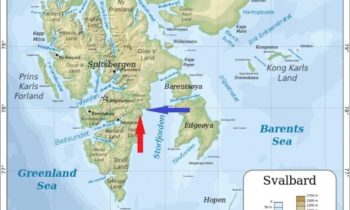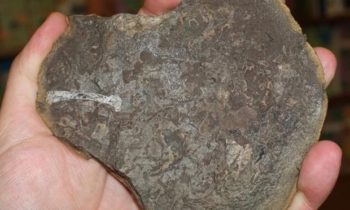 The fossil was originally found on Spitzbergen, the largest island of Svalbard, in 1962. Fifty years later it was rediscovered amongst uncatalogued material in the storage shelves of the University of Oslo’s Natural History Museum.
The fossil was originally found on Spitzbergen, the largest island of Svalbard, in 1962. Fifty years later it was rediscovered amongst uncatalogued material in the storage shelves of the University of Oslo’s Natural History Museum.
Palaeontologist Jørn Hurum came across the dusty fossil in 2011 down in the storage shelves of the Natural History Museum in Oslo. It had originally been found on Spitzbergen by the geologist Jenö Nagy in 1962.
Now, five years on, Hurum and a group of scientists have published a study showing this to be a remnant of a small bird or bird-like dinosaur that lived about 113 to 100 million years ago.
Little thighbone
The small fossil, from four to five centimetres long, was imbedded in rock and somewhat crushed. It would have been truly difficult to investigate such a fragile artefact five decades ago.
But thanks to computer tomography (CT) scanning technology, it could now be examined.
“We could see that this fossil was a bone, more specifically a femur,” says Aubrey Roberts, a research fellow from the University of Southhampton.
She is one of the scientists behind the new study.
 “The bone probably belonged to a bird, or a dinosaur closely related to birds,” explains Roberts.
“The bone probably belonged to a bird, or a dinosaur closely related to birds,” explains Roberts.
“We base that conclusion on several factors, but especially because the bone has very thin walls, a bird trait, as they have very hollow bones,” she continues.
In the trees amongst herbivores
The little creature was probably about the size of a common starling.
It would have lived among plant-eating dinosaurs in a temperate environment warmer than Norway’s arctic Svalbard Archipelago as we know it today.
When the creature was alive, in the Lower Cretaceous period, Svalbard was further south, but still at a latitude about 500 km north of today’s Oslo.
The landscape was lush, with conifers and gingko trees in a boggy landscape.
This particular creature appears to have fallen into water when it died. The femur became felicitously protected in the rock beneath a fossil mollusc shell.
This is probably why the fragile bone survived so well.
More traces
This is the first fossil vertebrate from this geological period, 113 to 100 million years ago, found in Svalbard or elsewhere in the Arctic. That makes it unique, but by no means a complete surprise.
“Footprints of dinosaurs from this period have been found earlier in Svalbard,” explains Roberts.
The tracks Roberts refers to on Spitzbergen were from herbaceous dinosaurs, ornithopods. These dinosaurs had three-toed feet, like those of birds.
Until now, only these footprints have given evidence of land species that roamed Svalbard in the early Cretaceous. Bones have been lacking.
But here was a fossil, literally right beneath the feet of palaeontologists working in the museum in Oslo.
I am the walrus
Oslo’s Natural History Museum is by far not the only one to have discovered hidden treasures in storage rooms. Scientists at the Norwegian University of Science and Technology recently found a walrus bone from Svalbard that turned out to be 6,600 years old, much older than believed.
Roberts expects there could be other hidden treasures amongst the collections of the museum.
“This could be. Now that the Geology Museum is moving we might discover more new things. This actually happens fairly often, new fossils turn up in museum collections,” says Roberts.
“Museum collections are often gigantic and artefacts can be lying about in storage and untouched a long time,” she explains.
Three million uncatalogued objects
Roberts is right about that. A professor at the Natural History Museum and a co-author of the study, Hans Arne Nakrem, says the museum’s collections contain about six million objects. And there are good reasons for using the qualifier “about”.
“These numbers come and go because an object with us here can be a bag containing from ten to a thousand tiny fossils. So we could count it as one object or one thousand,” he says.
Allowing a wide margin for such uncertainties, Nakrem estimates that about 2.8 million objects are covered by a database. But not everything the museum has in its possession is among these.
“The museums have been chronically understaffed the 30 to 40 years. We haven’t always had people who could catalogue objects properly,” he points out.
In addition, some of the collections are several hundred years old. The collectors of yesteryear were not always astute at describing or labelling what they had found.
“Some crates might be labelled simply ‘North America’, or perhaps, ‘Northern Norway:1910’,” he explains.
Nakrem thinks the museum will eventually get these collections sorted out.
“The quality of the collections is improving. Instead of hanging on to everything that is poorly labelled, the objects are thrown out, at least when they don’t have any scientific relevance,” explains Nakrem.
Back to the spot
But the fossil in question is one exception. Thanks to the geologist Nagy’s meticulous notes, the researchers were able to return to the area where the bone was found.
The scientists hoped to find more fossil bones from the same species.
They did not. But Roberts is still hopeful.
“It’s possible that there are more out there and future expeditions will certainly be looking for birds and dinosaurs. It would be fabulous to find some real huge, terrestrial dinosaurs here in Norway!” she says.
(sciencenordic)
